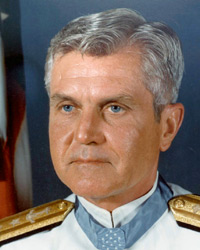James Stockdale
American pilot/author (1923 - 2005)

- || At The Bottom
1966 -- It was New Year's Day, and Navy Squadron Commander James Bond Stockdale lay in a North Vietnamese prison in Hoa Lo, where he'd been held since being shot down in September 1965. "I was shivering," Stockdale recalled years later, "legs in stocks, hands in cuffs, lying in three days of my own excrement." Conditions only grew worse from there. Stockdale, like most Americans captured during the war, was tortured on a regular basis. To emphasize their inferior position, captives like Stockdale were prohibited from looking anywhere but toward the ground, and they were even forced to bow at the waist in greeting the guards and officers who brutalized them. Stockdale lived under these unimaginable conditions for the next eight years, during which time the North Vietnamese shattered his legs, broke his back and yanked his shoulders from his sockets.
- || At The Top
1987 -- On March 16, 1987, 45 million Americans tuned in to watch "In Love and War," a television movie based on the letters Jim Stockdale wrote to his wife Sibyl during his years of captivity. The film -- and the book on which it was based -- chronicled the story of a husband and wife struggling to maintain hope in the face of tremendous adversity. By the late 1980s, Stockdale had become a well-known and respected figure in academia, having served a brief and rocky tenure as president of The Citadel before moving on to Stanford's Hoover Institution, where he had studied foreign relations in the early 1960s before his service in the Vietnam War. Although he was not an especially gifted public speaker, he was an elegant and thoughtful writer whose views on leadership -- forged out of his compelling personal story -- made him a sought-after figure at university graduations and business conferences. He would eventually achieve even more recognition as Ross Perot's vice presidential candidate in 1992, though his confused debate performance left many viewers with an inaccurate perception of his intellect. After his death in 2005, Stockdale was honored by the Navy, which named a missile destroyer in his honor and erected a statue of him at the Naval Academy in Annapolis, Maryland.
- || The Comeback
In the years after his 1973 release from North Vietnam, Stockdale credited the Stoic philosophers, particularly a first-century Greek named Epictetus, with giving him the perspective he needed to endure his captivity. Stockdale learned from the Stoics that individual misfortune could be overcome by focusing one's attention on maintaining timeless, universal virtues. As Stockdale explained in a 1993 speech, Epictetus taught him that humans cannot be truly victimized by anyone but their own selves. "To the Stoic," he wrote, "the greatest injury that can be inflicted on a person is administered by himself when he destroys the good man within him." As a prisoner, Stockdale realized that while his captors might attack his body, they could not destroy his moral integrity; therefore, even as a prisoner, Stockdale recognized that he could control his own destiny, that he was not in fact defeated. After his ordeal was over, Stockdale built a career of writing and teaching that showed people how to prevail over misfortune and lead others along a path of personal development.



